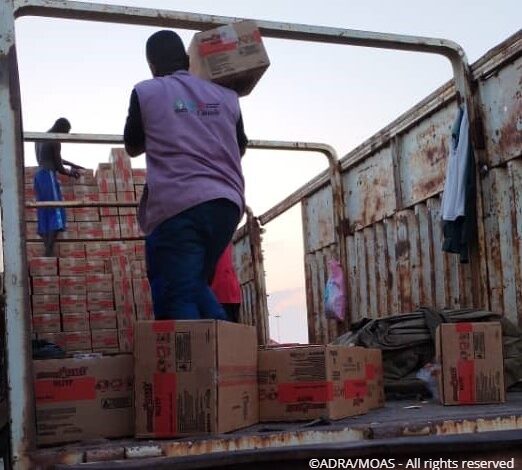Food insecurity remains a pressing and pervasive challenge in Sudan, perpetuated by a combination of internal conflicts, economic instability, and environmental factors. Worsening this situation, the prolonged conflict that broke out last April has put even more people on the brink of despair.
A country on the brink
The country has endured prolonged periods of civil unrest, disrupting agricultural activities and displacing countless communities. Economic challenges, exacerbated by high inflation rates and a weakened currency, have further strained the ability of vulnerable populations to access and afford basic food necessities. Additionally, Sudan faces the harsh impacts of climate change, with recurring droughts and desertification affecting agricultural productivity.
The convergence of these factors has created a precarious situation where a significant portion of the population, particularly in conflict-affected regions, grapples with insufficient access to food. To date, according to the WFP, nearly 18 million people are facing acute food insecurity, of whom 5 million are in emergency levels of hunger. This number has tripled since 2019 and is growing month by month.
Our project, developed in collaboration with our long-standing partners Edesia Nutrition and ADRA Sudan, has already provided 52 tons of therapeutic food to be distributed to the country’s most affected communities, as mentioned in our previous blog. Our products are designed explicitly for children suffering from acute malnutrition, being Sudan, one of the countries facing this tragic situation in the world. Read this blog to explore further malnutrition and the products we provide in the country. Since the escalation of the conflict, in total, around 14 million children urgently need humanitarian assistance in Sudan, a number that is bound to increase dramatically without effective and prompt action.
#MOASForSudan and food insecurity
In Sudan, our mission delves deep into the complexities of food insecurity, an issue intricately woven into conflict, economic turmoil, and environmental challenges. Sudan’s story is one of resilience against adversity, and our mission aims to be the beacon of hope.
This week, we are pleased to host an interview with Maysa Al-Aqil, ADRA Sudan Programs Director, to better understand the dynamics that drive food insecurity in the country.
What are the leading causes of food insecurity in Sudan?
There are several causes for food insecurity, and it is important to mention that despite the conflict exuberating the needs, the Sudanese population were already struggling to meet their most basic food needs. Even before the conflict, the situation was rapid inflation, insecurity after the coup, and sporadic inter-communal conflict led to Over 70% of the country depends on agriculture as the main source of income and a large number of those are rained smallholder farmers. The conflict came over.
Who are the most affected areas/populations?
As per the Sudan Humanitarian Needs Overview 42% of the population (20.3 Million people) are now experiencing high levels of food insecurity. This has been driven by conflict and displacement across several states. This is especially true for Khartoum, and Darfur states. The Kordofan regions. Furthermore, with the increase in WASH needs and AWD/Cholera, malnutrition rates among children u5 and PLW are also on an alarming increase.
How have the recent weather hazards further hindered food security?
Erratic rainfall and drought have been one of the main climatic drivers for food insecurity in the past three years. Especially as the majority of the rural population depends on rain-fed farming both for sustenance and income.
What are the main impacts of food insecurity on the people of Sudan?
Food insecurity will lead to an increase in the mortality and morbidity rates among children and mothers; Sudan is already one of the four countries with the highest prevalence of global acute malnutrition (GAM) rates in the world (13.6%). The nutrition outlook is also anticipated to deteriorate in 2024 due to the ongoing conflict and food insecurity situation, as well as the compromised health and WASH services, where the number of malnourished children is expected to rise by 10-30% in conflict hotspots, surpassing 4.7 million, the highest ever estimated in Sudan. Around 76 per cent of acutely malnourished under-five children, pregnant and lactating women reside in 103 localities.52 Micronutrient malnutrition is prevalent, with 48 per cent of under-five children experiencing anaemia due to iron deficiency. Minimum dietary diversity among under-fives is low at 25 per cent, further exacerbated by massive displacement disrupting feeding and caregiving practices.
What are the primary forms of humanitarian food assistance in Sudan?
WFP has been working on half food rations for IDP caseloads across Sudan and in Darfur. However, the main source had been cash distribution especially when dealing with the urban caseloads.
What do deliveries of therapeutic foods, such as those provided by MOAS and ADRA, mean for communities in crisis today?
ADRA, through funding from BHA and with its health partner Medair, had been instrumental in countering SAM and MAM cases. The lack of supplies for the MAM cases had usually meant that many of the children defaulted. When not receiving any assistance, the mothers often wouldn’t stick to binging their children for follow-up in the health facilities, especially considering the distance they have to cross to get there. Now, with the assistance and when the women see that they are receiving a “cure” for their children, they are more motivated to attend, and other mothers are also bringing in their children to be checked. ADRA and Medair noticed a significant increase in cases showing up in the health facilities for MUAC screening.
Final thoughts
Humanitarian organizations are working tirelessly to alleviate the crisis, providing emergency food assistance, supporting agricultural development, and advocating for long-term solutions to break Sudan’s food insecurity cycle. But the increasing challenges put a strain on the assistance, as we already show in this blog, hindering the work carried out by organisations and NGOs. With our partners we work tirelessly to support those in need, trying to give them the future they deserve. But only with your support, we can continue our life-saving mission.
Please donate now; every contribution counts: https://www.moas.eu/donate-moas-sudan/.
If you are interested in the work of MOAS and our partners, please follow us on social media, sign up for our newsletter and share our content. You can also reach out to us at any time via [email protected]. If you want to support our operations, please give what you can at www.moas.eu/donate.


